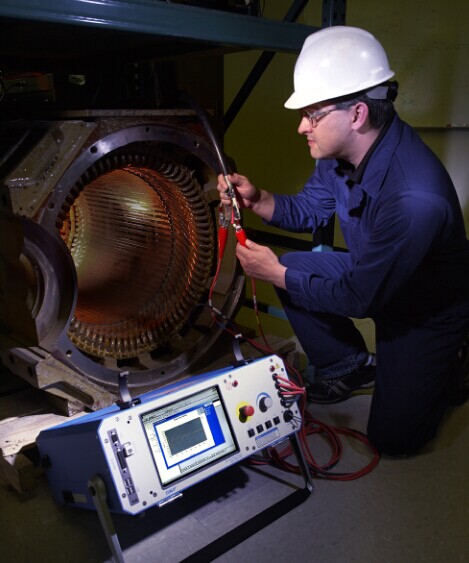- Hello Customer - Log in or Register!

A custom-designed interface for SKF Baker motor testing rigs has helped a US freight company to improve maintenance procedures while cutting costs at the same time, says Mike Teska, Product Line Manager at SKF
Keeping freight trains on the rails is a major behind-the-scenes operation – and if not done well, can lead to very expensive unplanned repairs. These costs can be managed by regular testing, which ensures that potential failures are picked up well in advance.
Failures of AC traction motors in freight rail systems are a major component behind breakdowns. Despite this, testing regimes for AC traction motors are often incomplete, and do not verify the entire motor. At the same time, testing is often technician-specific: there is often no clear method to ensure that all tests are performed, or that all results are accurately recorded.
BNSF, a major rail freight company in the US, was faced with these types of problems. It wanted to improve uptime and reliability of its trains, as it was seeing a lot of motor failures while the trains were on the rails. This made for expensive repairs, of the traction motor itself and often also of the drives for the motor.
This is where SKF Baker stepped in to help. It supplied 24 of its Baker AWA-IV automated motor test rigs to BNSF, which allowed the company’s technicians to perform more extensive testing of its AC traction motors. In addition, the devices were fitted with a custom-designed user interface that helped the technicians perform the tests more consistently – by guiding them through each test procedure. The interface was built specifically for BNSF, but can easily be adapted to the requirements of other rail companies.
Switching kits
BNSF had been using a different test rig for its motors, but the equipment was coming up short: it only verified groundwall insulation and could not give critical information about the windings, for example, the turn-to-turn insulation – which is the most prevalent cause of electrical motor faults. The Baker AWA-IV offered more complete fault coverage, which was crucial for improved motor reliability. AC traction motors for diesel electric trains are driven by variable speed drives (VSDs), which put a great stress on the motor windings due to fast voltage transients. Identifying winding failures in this case is therefore critical.
However, using the right piece of test kit was only part of the answer. Trains are complicated pieces of equipment. When they are tested, they must be tested properly – and consistently. It was vital to ensure that every technician in the organisation carried out exactly the same test – in terms of the order in which the tests were done, and with the same parameters and limits.
So, SKF Baker developed a customised user interface for the device to guide the technician through the entire test and troubleshooting process.
Introducing a consistent test regime across the organisation meant introducing a centralised ‘master’ test sequence. It is accessed from a central location – and can be adjusted if necessary. So, if test conditions need to be changed, by altering a test voltage or duration, for instance – these can be made centrally, then automatically updated on each AWA test device.
Special relevance
Consistency of testing is always important, but it has a special relevance here. Ordinarily, a repair shop within an organisation will handle a wide variation of motors and is unlikely to see two identical motors in a six-month timeframe. In this case, however, the same locomotives and motors are coming in every day, so it makes perfect sense to introduce as much automation and consistency as possible.
The test sequences are centralised, but so are the test results. This allows the company to run effective reports by analysing multiple test results. Data might reveal how a motor should be shielded, for example, or a systemic weakness in the feeder cables that are connected to it.
BNSF also asked specifically that test results be displayed as a ‘pass/fail’, rather than a specific value. This means that technicians are not tempted to re-test a motor if the result is ‘close’. The full detailed test results are centrally stored, allowing for statistical control of the tests. Again, this takes another level of variability out of the test procedure.
The custom interface was designed specifically for BNSF, but can be modified quite easily for other rail companies: every company has different job safety requirements, test regimes and different specific test parameters, and each new interface can take account of that. For instance, BNSF incorporated a test procedure to allow for ‘rain conditions’. In a repair shop, a train is sheltered – but out on the rails will frequently be subject to extreme weather. The SKF Baker interface implemented a test procedure whereby, after the ‘standard’ test, the motor leads were sprayed with water and the motor was re-tested. This is the kind of ‘test logic’ that is beyond the capability of standard test rigs.
The interface certainly worked for BNSF: after switching to the SKF Baker AWA-IV test rigs, the enhanced testing capability – and greater consistency – resulted in a 5 per cent reduction in motor failures per year, and 40 per cent reduction in phase module removals.
And, with a return on investment within one year, it was money well spent for the company.
The SKF Baker AWA-IV, with custom interface, will be seen at the Innotrans exhibition in Berlin, on 20-23 September 2016.
Aktiebolaget SKF
| Product Model | Inside Diameter | Outside Diameter | Thickness |
| 6011-RSC3 bearing | 55 | 90 | 18 |
| 6011-ZC3 bearing | 55 | 90 | 18 |